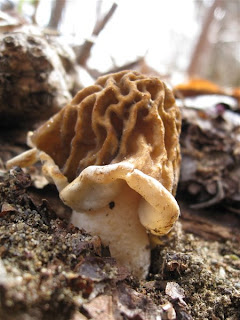
When will this winter release us from its clutches? I'm ready to do a dance. To carry around a pouch stuffed with rattlesnake bones and chicken beaks. To fill the night with incantations.
Heading east on I-90 yesterday, I wasn't even out of Bellevue and the snow was already swirling around the car like a mad swarm of insects. Several more miles up the highway and my intended destination for harvesting stinging nettles and fiddleheads was covered by a few inches of fresh snow. I could see this obvious fact at 70 miles per hour.
Plan B.
I pushed on over the pass to the "sunny side of the mountains." The white stuff was falling in downtown E-burg. A hay rancher blew snow with his irrigation line.
 All was not lost, however. Spring is fighting back. I found a sign of the season (several, in fact) right where it should have been, hiding among dead leaves beneath a tall cottonwood down by the river. Witness Exhibit A, Verpa bohemica, known to some as the "early morel."
All was not lost, however. Spring is fighting back. I found a sign of the season (several, in fact) right where it should have been, hiding among dead leaves beneath a tall cottonwood down by the river. Witness Exhibit A, Verpa bohemica, known to some as the "early morel."Eating verpas is not advisable, though plenty of folks do. They're mildly toxic and the toxins can build up in your liver over time. They don't taste nearly as good as true morels either. But most mushroom hunters get excited when they find a verpa because it can mean only one thing: True morels are right around the corner.
You can distinguish verpas from true morels a couple of ways. The cap of a verpa rests delicately on the stipe, with a skirt that hangs over, unattached at the hemline. Slice one open and most likely it won't be hollow like a morel; it will have some cottony material inside.
 This pair of verpas to the left had dried out caps, indicating that either they fruited a while ago, or, more likely, they decided to pop their heads up after that three-day warm spell last week only to get promptly frost-bitten for their trouble.
This pair of verpas to the left had dried out caps, indicating that either they fruited a while ago, or, more likely, they decided to pop their heads up after that three-day warm spell last week only to get promptly frost-bitten for their trouble.I checked some of my other spots while I was at it. Snow, snow, and more snow. Where there wasn't snow, the ground was cold and mostly dead-looking, excepting the bravest green shoots testing the air. While morel hunters are enjoying a banner year in most of the country, I fear the season could be a short one in my neck of the woods.

Such a great feeling, isn't it, being on the brink of a new season -- asparagus, snap peas, morels. Hope you had some tasty eats tonight.
ReplyDeleteEnjoying your blog lots. I'm no forager, so it's great to hear about the amazing things growing in our woods.
I picked up some Verpas at the Farmers Market a few weeks ago-came home and did some research. I found out just what you said- they can be toxic. I ate them anyway (hey, they were expensive) and had no ill effects. They did have a hollow stem. Do you think they could have been morels instead?
ReplyDeleteAudrey - Keep reading and we'll get you out into the woods eventually. It's addictive!
ReplyDeletePoppy - I've heard about verpas being sold at Farmer's Markets. Seems like a risk to me. I didn't eat mine. Although truth be told, most people don't get sick from what I understand--although jury is still out re: long-term effects if you eat enough. The stems are not always cottony inside; best way to tell a verpa is by how the cap is attached to the stem. If it hangs over, unattached, it's a verpa. There's a type of true morel called a semilibera or half-free morel that's sort of intermediate between a morel and verpa. You can read more about it here.